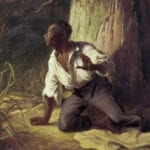 Mysteries
Mysteries  Mysteries
Mysteries  History
History 10 Surprising Stories About the Texas Rangers
 Humans
Humans 10 Philosophers Who Were Driven Mad by Their Own Theories
 Miscellaneous
Miscellaneous 10 Video-Game-Worthy Weapons and Armors from History
 Weird Stuff
Weird Stuff 10 Psychics Who Accurately Predicted Wartime Events
 The Arts
The Arts 10 Pieces of Art Inspired by a Broken Heart
 Health
Health 10 Science Fiction-Sounding New Medical Treatments
 History
History 10 Surprising Facts About the Father of Submarine Warfare
 Space
Space Ten Astonishing New Insights into Alien Worlds
 Weird Stuff
Weird Stuff 10 Bizarre Summer Solstice Rituals Still Practiced Today
 Mysteries
Mysteries Top 10 Haunting Facts About the Ghost Ship MV Alta
 History
History 10 Surprising Stories About the Texas Rangers
 Humans
Humans 10 Philosophers Who Were Driven Mad by Their Own Theories
Who's Behind Listverse?

Jamie Frater
Head Editor
Jamie founded Listverse due to an insatiable desire to share fascinating, obscure, and bizarre facts. He has been a guest speaker on numerous national radio and television stations and is a five time published author.
More About Us Miscellaneous
Miscellaneous 10 Video-Game-Worthy Weapons and Armors from History
 Weird Stuff
Weird Stuff 10 Psychics Who Accurately Predicted Wartime Events
 The Arts
The Arts 10 Pieces of Art Inspired by a Broken Heart
 Health
Health 10 Science Fiction-Sounding New Medical Treatments
 History
History 10 Surprising Facts About the Father of Submarine Warfare
 Space
Space Ten Astonishing New Insights into Alien Worlds
 Weird Stuff
Weird Stuff 10 Bizarre Summer Solstice Rituals Still Practiced Today
10 Interesting Aspects of Leprechauns
“Lay your ear close to the hill.
Do you not catch the tiny clamour,
Busy click of an elfin hammer,
Voice of the Lepracaun singing shrill
As he merrily plies his trade?
He’s a span
And a quarter in height.
Get him in sight, hold him tight,
And you’re a made
Man!”
These lines from “The Lepracaun, or Fairy Shoemaker” by Irish poet William Allingham (1824-1889) pretty much sum up the little guy’s stature, shoemaking trade, and the myth that capturing one leads to great wealth. But these mischievous elves have acquired throughout the centuries many other interesting traits and attributes that might well be worth exploring, for as the old saying goes: “Catch hold of a leprechaun and don’t let go, for he will tell you the address of the gold that is unknown…”
Related: 10 Mythological Creatures That Really Existed (Sort Of)
10 Leprechauns at One Time Were Thought to Be Water Sprites
The legend of the leprechaun grew out of pre-Christian Irish mythology surrounding an ancient, supernatural race called Tuatha Dé Danann, in which they were first imagined to be mischievous water spirits. As early as the eighth century, The Saga of Fergus mac Léti tells the story of a legendary king of Ulster who was kidnapped and dragged into the sea while sleeping by three tiny water sprites called “lúchorpáin.” After being awakened by the cold water, the good king snatched up the little imps in one hand and demanded three wishes in return for their freedom. However, their trickery and deception in doing so led to his eventual downfall.
Over time, the cultural perception of leprechauns morphed into bearded fairies about three feet tall who lived in underground caves or hollow trees, and their legend and lore became more plentiful. Clad in red (yes, red!) jackets and breeches, with cocked hats atop their wizened heads, they were often depicted in folk tales as industrious cobblers whose fortunes were hidden away within pots of gold. But despite the physical differences from their water-spirit days, tricksters they still remained.
In one version of an ageless, Irish folk tale, a farmer named Jack encounters a leprechaun hidden away in the hedgerow. Following tradition, he forces the elf to reveal where his pot of gold is hidden by keeping him within his gaze. The leprechaun is unable to resist and leads the farmer to a sprawling field of dandelions, where he indicates the particular flower that sits upon his buried crock. But Jack has no spade for digging and must return home to get one.
While the leprechaun is still under his spell, he commands him to leave the gold exactly where it is buried until he returns. Again the little guy is helpless to resist, and Jack places one of his stockings over the flower as a marker before heading home. But when he returns, he finds that the leprechaun has covered each and every one of those thousands of dandelions with identical socks, tricking the greedy farmer and keeping his gold. However, the tale ends on a high note, for the farmer’s wife is delighted at the lifetime supply of stockings that she generally had to knit from scratch.[1]
9 “Leprechaun” Is a Very Odd Word Indeed!
Let’s start with the etymology. As previously stated, the earliest mention of the creature was in the form of rascally water spirits called “lúchorpáin,” which literally means “little bodies” in Old Irish. Furthermore, scholars attribute the alternate spelling “leithbrágan,” which translates to “half shoemaker,” to the common depiction of leprechauns working on just one solitary shoe. While many linguists attribute the one-shoe theory to folk etymology, which is sort of a play on words, they offer yet a third possibility in the Latin word “Lupercalia,” an ancient Roman festival of debauchery in which young priests called “Luperci” ran about naked. Over the centuries, a medieval Irish legend developed in which the concept of the “Luperci” had morphed into supernatural super-swimmers who had survived the Great Flood, only to haunt the waters of Ireland—which brings us full circle back to the “lúchorpáin” of water-spirit notoriety!
And how exactly do we spell it? This article is entitled with the standard American spelling, but let us remind ourselves that leprechauns come from a land of diverse counties and lordships that reach far back in time. While “leipreachán” seems to be the Irish standard, alternate spellings include “loimreachán,” “lubrican,” “luchramán,” and “lúracán.” He’s called the “logheryman” in many northern counties, the “lurigadawne” in County Tipperary, and the “luricawne” in County Kerry. Heck—it’s almost as if at one time in Old Ireland, every other household had a different spelling for the crafty, little cobblers! But after all, leprechauns are the ultimate and original tricksters in all manners of deception and disguise, which apparently includes vocabulary.[2]
We could also discuss the many alternate pronunciations, but that would be cruel!
8 Leprechauns Are Mean and Ugly!
Americans tend to think of leprechauns as harbingers of good luck and four-leaf clovers. However, that perception really springs from the combined cultural influences of an old Disney movie, a popular brand of breakfast cereal, and St. Patrick’s Day imagery. If we were to assign a more appropriate observance to the little tricksters, however, it would most likely be April Fool’s Day—possibly Friday the 13th!
In Ireland, the leprechaun is traditionally considered to be a sly, sometimes malicious little elf who enjoys tricking people, especially those interested in stealing his gold. They are the masters of pranks and prevarication, and even if you catch one and demand three wishes, it will certainly not end well. They also like to hit the sauce, either drinking their own brew or perhaps stealing yours. But be careful what you say to them if they do as they’re very proficient at casting curses, and out of spite, they’ve been known to make a household’s milk turn sour.
Leprechauns were also described as being rather untidy in both dress and grooming and were known to carry a repugnant odor. They were considered quite ugly to the point of deformity. They were also accused of having surly manners that matched their ragged appearance. In his 1888 compendium of Celtic lore, writer D. R. McAnally described the leprechaun to be of horrific parentage, with an evil spirit for a father and a degenerate fairy for a mom. And with references like those who could blame the little guys for occasionally hitting the sauce.[3]
7 There Are No Leprechaun-esses
Have you ever noticed that leprechauns are always male? There have never been female leprechauns in the history of Irish folklore, which might be part of the reason the males are known to be solitary and rather grouchy creatures. Of course, tiny, drunken cobblers probably wouldn’t do well on the dating scene anyway, but then how do these mean little buggers reproduce other mean little buggers without female counterparts?
For one thing, they seem much too clever and ornery to just up and die. Legend has it they’re either extraordinarily long-lived or perhaps even immortal, but all that still doesn’t explain where they come from. One school of thought claims they hatch from eggs, but it’s unclear who or what actually lays these eggs. And according to A History of Irish Fairies by Carolyn White, leprechauns are the deformed children of fairies—their ugliness and bad dispositions probably precluding them from being proper husbands even if she-leprechauns did exist!
Single-gender, supernatural species are common in the folklore of the British Isles. Leprechauns are considered solitary fairies, which are generally ill-tempered and reclusive. Other examples of solitary fairies are the British hobgoblin and the Scottish brownie, both of which are almost always portrayed as being male. Conversely, the Irish banshee, a wailing harbinger of death, is always female. Solitary fairies are distinguishable from trooping fairies, the smaller, more conventional winged pixies and such that come in both genders and who actually smile from time to time—a gesture that seems to do wonders for a fairy’s social life.[4]
6 Pot O’ Gold Morality
Most fairy tales and fables offer a moral or lesson at the conclusion of the story, and leprechaun lore is no different. Their pots of gold at the end of the rainbow, and the covetous men who try to find them, are working examples of that deadly sin called greed. And in turn, the trickery leprechauns inflict upon such men are examples of comeuppance and reminders that easy money schemes most generally never end well.
Many of these stories follow a certain pattern, starting with a farmer, or some other sort of ordinary fellow, stumbling across a leprechaun caught tapping at a shoe. Following legend, the wizened elf is either frozen by the man’s stare or by his grasp as he demands the location of its gold. In a good number of these tales, the leprechaun is either successful at breaking the man’s stare by cleverly averting his attention or at breaking free from his grasp through some other form of trickery, after which it flees.
In other versions of the story, the man is successful at being brought to the gold, which is always buried deep beneath some type of flower or weed. He then departs to retrieve a spade or shovel from home, first making the leprechaun promise to leave the bounty right where it is. But when he returns, he finds thousands of those same exact flowers, leaving him clueless about where to start digging. In other manifestations of the tale (such as the one previously told above), there are already thousands of flowers when he arrives with the leprechaun, so he marks the correct one with a stocking or other item of cloth. And always, upon returning with the spade, he finds each one of those flowers marked with identical items. Thus the punishment for his greed and arrogance!
Another legend warns against inhospitable behavior, at least when there’s a leprechaun in need. The crafty cobblers are known to earn their gold by making shoes for other fairies. However, when business is slow and they’re short on cash, they resort to knocking on the doors of human homes peddling their trade. If you hire one, you’ll get a great pair of shoes, plus you’ll be off the hook because if you turn one away, he’s likely to cast a curse on your household. And anything from spoiled milk to a broken leg will be looming on your horizon. Disgruntled leprechauns can get pretty darn mean and cantankerous, and most especially after dark.[5]
5 The Contemptible Clurichaun (aka Leprechaun After Hours)
There is a lesser-known creature in Irish folklore called the clurichaun—a cantankerous, drunken cur whose manners are absolutely deplorable! Interestingly enough, it looks like a leprechaun, dresses like a leprechaun, and even hides its gold like a leprechaun. The only difference between the two is that leprechauns seem to have boundaries to their malicious nature. In contrast, clurichauns are downright evil—and generally at night! Many folklorists think the two types of elves are actually regional variations of the same creature, with the daytime leprechaun showing attributes of hard work, frugality, and clever trickery, whereas the nighttime version (the clurichaun) parties hearty, raiding wine cellars while pranking both lords and maidservants alike.
One of the main differences between the two is that after a leprechaun curses a household, he makes a quick exit, unlike the clurichaun who actually moves in and sets up camp in the cellar, attic, or wherever the booze is stored away. A frequent theme in clurichaun lore is of afflicted gentlemen moving out of their homes to escape the conniving, little beast, only to have it follow them to the new house. Clurichauns are actually capable of paying allegiance to worthy hosts if they so choose, faithfully guarding their wine and beer, but disloyal servants, especially ones who steal a sip here and there, get haunted, harassed, and occasionally beaten up.
Another similarity the two ornery elves share is the fear of being caught and having to hand over their gold. However, this seems to happen much more frequently with the much less acerbic leprechaun. When a clurichaun is captured, the tales follow the same template patterns as the ones of the captured leprechauns detailed above; another reason many folklorists believe the two pranksters to be one and the same. As a matter of fact, many linguists consider the word “clurichaun” to be a dialectal variation of “leprechaun” in certain southern regions of Ireland; either way, the wine cellars toward the north must seem a tad bit cozier and inviting than in the south.
In his 1828 book Fairy Mythology, Thomas Keightley tells the tale of a clurichaun called Little Wildbean who haunts the cellar of a good Quaker named Harris. The creature thoroughly looks after the beer barrels for the master of the house, and in return, his servants feed him nightly. Little Wildbean’s temper flares one evening, however, after being served a shoddy supper, and he assaults the cook severely at midnight. Harris has had enough and flees his home, leaving the clurichaun far behind—or so he thinks! After discovering the little imp hidden in one of his empty barrels, he resignedly returns home with Wildbean, where he shortly thereafter buys the proverbial sheep farm. The conniving clurichaun, however, remains in that house to this day, but as for the cook—all bets are off![6]
4 The Americanization of the Leprechaun
During the mid-nineteenth century, the Irish constituted more than one-third of all immigrants to the United States due to the devastation of the 1845 Potato Blight. The concept of St. Patrick’s Day parades was already somewhat present in America at that time, but they only increased in numbers and sentiment as hundreds of thousands of displaced Irish found comfort in a celebration of their culture.
During this period in U.S. history, Irish-Americans were often the victims of ridicule and prejudice, with cartoon depictions of their rumored drunkenness and signs that read “Irish Need Not Apply” being commonplace. But after their participation in the Civil War, Americans started to look upon the Irish with a more generous nature, and St. Patrick’s Day celebrations became popular for people from all backgrounds. But so many of the old traditions brought from overseas quickly became Americanized, perhaps trivialized. The leprechaun was one of the more prominent symbols of the Emerald Isle that soon became tarnished.
Probably the most profound shift in the development of the Americanized leprechaun was its attitude change, having morphed from the status of an ugly, grouchy, wrinkled fairy into a smiling, dashing, little gent holding a four-leaf clover for good luck. And gone is the creature’s tiny, red coat which it wore for centuries (often to mock the British). Instead, it was replaced by an outfit of green, the color that became synonymous with Irish heritage in the U.S.—despite the fact azure blue was traditionally Ireland’s most symbolic color. And what’s with the carrot-orange hair and beard? Folkloric descriptions of leprechauns simply describe them as being old as the hills, which implies any hair atop their heads or below their chins should be gray or white. But America already had a Santa, and, after all, many Irish-Americans indeed were redheads.
The typical portrayal of the leprechaun offends many people of Irish heritage as it is a false image purely the creation of American amusement. And whereas modern-day, humorous depictions of the little green elves are meant with good intentions, that hasn’t always been the case in U.S. history. The leprechaun’s excessive drinking and his centuries-old costume were at one time derogatory symbols used against the Irish with such frequency that they have become firmly ingrained within the collective pop-cultural imagery of America.
Ironically, the American version of the leprechaun and other Irish stereotypes have become increasingly popular across the Atlantic by the actual Irish due to television and the internet, through which they see how much fun we have on March 17. In Ireland, St. Patrick’s Day is a church holiday, and up until 1961, pubs were closed for the observance. But since then, the celebrations and parades have grown popular, and in 1995, the Irish government started promoting “Paddy’s Day” as a boon for the tourism industry, which includes a five-day festival in Dublin that in 2019 brought in €73 million (83.4 million USD) to the economy. For the last two years, however, COVID has kept all would-be leprechauns at home, but the festivities are on for 2022—all fingers crossed![7]
3 “They’re Magically Delicious!”
In 1964, General Mills came out with a new breakfast cereal called Lucky Charms, the novelty of which included marshmallow bits in clever shapes and a leprechaun on the box. For well over fifty years now, Lucky the Leprechaun has been trying to keep kids from snatching his cereal. His popularity as a brand mascot has put him right up there with Tony the Tiger, Toucan Sam, and Snap, Crackle, and Pop (fellow elves)!
At this point, it’s been almost thirty years since the consumption of cold cereal started to decline due to dietary and lifestyle changes, gluten-free issues, and a slew of alternative breakfast options such as drive-thru fast food, breakfast bars, and microwavable morning meals. And to offset that loss of sales, cold cereal companies have tried marketing new flavors, new shapes, new colors, and new box designs, so much so that it’s almost more confusing these days to choose a box of cereal than it is to buy a car! But Lucky Charms are just as popular as ever, with sales actually increasing. Of course, it helps that there’s a handful of candy in each serving, but Lucky has a “charm” all his own and stands out as a brand mascot in many ways, including a new streaming musical marketing campaign promoted on Spotify.
But mascots beware! The Notre Dame Fighting Irish has had a leprechaun as their official mascot since 1965. But some people are starting to claim that the symbolism of an angry, little Irish elf with his dukes up ready to fight is offensive. In a survey conducted in 2021, the leprechaun was voted the 4th most offensive collegiate sports mascot, which in turn offended both the Indiana university and its team. They argue that the issue is nothing like the Redskins controversy, as Irish individuals have actually had input into the formation of the university; regardless, many people find the leprechaun’s fighting stance to be a stereotypical slur against the Irish.
And similar sentiment has been expressed against the NBA’s Boston Celtics leprechaun mascot, which some people think looks tipsy or at least goofy. Will the forces of political correctness eventually go after the Lucky Charms leprechaun too? If so, look out, Lucky, for whereas leprechauns may have escaped capture for hundreds of years in Ireland, the American PC police might be the ones to actually do you in.[8]
2 No More Leprechaun Movies—Please!
In 1993 Jennifer Aniston of Friends fame starred in her very first movie, Leprechaun, which was the start of a franchise that currently includes eight movies, the first six featuring Warwick Davis in the title role. And while the general opinion of Aniston is still pretty flattering, the general opinion of the Leprechaun movies is that they royally suck! The first movie got hideous reviews, mainly because the plot was an odd mix of humor and horror in mismatched proportions. Yet, Hollywood came out with the sequel just one year later—another cinematic catastrophe that received even worse reviews. And the sequels just got worse, with such titles as Leprechaun 4 in Space (1996) and Leprechaun in the Hood (2000). Of course, Hollywood came out with a revamp in 2014 called Leprechaun: Origins, an abomination that got a zero Tomatometer score on Rotten Tomatoes—yes, that’s right, the score was ZERO!
But like many B (perhaps C?) movies of the horror genre, over time, Leprechaun has acquired a cult following that faithfully gathers each year to enjoy the carnage on March 17. This cinematic reverence has placed the series of movies amongst other odd horror cult classics such as Attack of the 50 Foot Woman (1958), Night of the Living Dead (1968), and Attack of the Killer Tomatoes (1978). Though honestly, a better holiday to view Leprechaun might actually be Halloween rather than St. Paddy’s.
Talk has it that there’s yet another sequel and/or revamp being pondered, and considering all the other crappy Hollywood movie franchises that keep re-emerging, it’ll probably happen. Though if another Leprechaun movie does come out, it’s a safe bet that one of the Lucky Charms Spotify music videos mentioned above could rate a better Tomatometer score.[9]
1 The Naked Leprechaun of Carlingford
The legend of the leprechaun is one the Irish apparently hold dear, at least according to a survey taken in Ireland in 2011 that concluded 1/3 of participants actually believe in leprechauns, while more than half believe they existed in the past. To be fair, the survey was conducted by a whiskey distillery right before an organized, annual leprechaun hunt. However, the elusive elves had already been officially recognized in 2009 when the European Habitats Directive deemed them to be a protected species, at least in one section of County Lough. This is how it all happened:
Back in 1989, a pub owner from Carlingford, County Lough, named P.J. O’Hare, after hearing a horrific scream from up on Slieve Foy (a local mountain), found several small bones among a small green suit, matching hat, and four gold coins. This “absolute proof” of a leprechaun (apparently left naked and missing a few bones) was on display in his establishment for years until he died, after which the pub was sold. Unsurprisingly, the four gold coins went missing.
Several years later, P.J.’s old mate, Kevin “McCoillte” Woods, claims to have found the gold coins hidden away within a stone wall, after which he gained the gift of gab with leprechauns, three of whom he says he stumbled across while hiking through Slieve Foy with his dog. McCoillte asserts that there are exactly 236 leprechauns living in the vicinity, the last of a race that has died off. He added the tiny costume and coins found by his friend P.J. had been left there intentionally.
McCoillte’s story gathered quite a following, and in 2009, after years of lobbying the EU, the leprechauns in Carlingford were granted protected status on the grounds that the European Habitats Directive was unable to prove or disprove their existence. And now, each year, McCoillte sells hundreds of hunting licenses for a ceramic leprechaun hunt held in March on the Sunday that clocks move forward, with proceeds helping out local charities. Tours are also available all year long through the cavern where the leprechauns are rumored to live, with tickets priced at €10 per adult. Talk about a pot o’ gold…
And if you’re questioning the veracity of McCoillte’s tale, or the authenticity of the tiny elf costume, rest assured that this story came straight from the mouths of the fine leprechauns of Slieve Foy in County Lough.[10]








